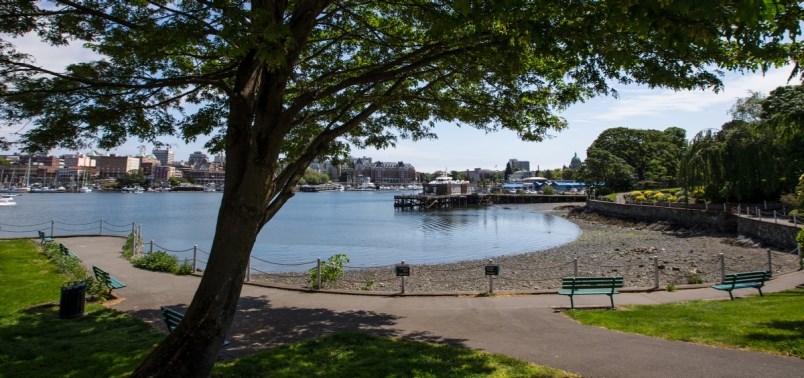Transport Canada has awarded a more-than-$17-million contract to remove contaminated soil from Laurel Point Park, a former industrial site used to manufacture paint.
QM/JJM Contracting JV will remove contaminants from the park and harbour, according to an announcement made Saturday by Joyce Murray, Liberal MP for Vancouver-Quadra, on behalf of Transport Minister Mark Garneau. The remediation work is expected to start in early October and take 12 to 18 months.
In May, the City of Victoria announced it will contribute $3.1 million to Transport Canada’s planned cleanup of its lands that flank the park. The massive undertaking is estimated to cost $20 million to $25 million.
The Laurel Point Peninsula was home to the British American Paint Company factory from 1906 to 1975. Paints, varnishes and lacquers were manufactured there. Paint and raw products were stored at the site in both underground and above-ground storage tanks.
Prior to 1885, the area was used as a burial place by First Nations.
Analysis found that contaminants in the soil such as metals, petroleum hydrocarbons, chlorophenols and polychlorinated biphenals (PCBs) exceed regulatory standards.
While park users are not considered to be at risk, park or construction workers exposed to repeated soil disturbances will have to take precautions, such as using protective equipment.
The work involves removing about 35,000 cubic metres of contaminated soil and replacing it with clean soil. Barges will transport both types of soil to and from the site.
The city has agreed to cover about $50,000 for removal and storage of city assets, such as public art, from the federal lands.
Site preparation is already underway and expected to continue for the rest of the month. Park benches and a cannon have been removed, while the gazebo has been moved to nearby Centennial Park on Belleville Street.
There will also be costs in subsequent years, after remediation, for testing of samples from the site and risk assessments. In the year after remediation is finished, that might cost $300,000.
Transport Canada is holding a public information session on the project Tuesday at city hall from 7 p.m. to 9 p.m.
The harbour is shared by industry, tourism businesses and local wildlife and is an example of how the environment and the economy go hand in hand, said Murray.
The project will preserve the park as a feeding ground for wildlife, a place for locals to relax and an attraction for tourists, she said.
Murray also announced Transport Canada has spent $31,346 to remove six derelict boats on the B.C. coast, including four removed from the Gorge Waterway by Salish Sea Industrial Services in Victoria at a cost of $19,685.
The funds come from the federal Abandoned Boats Program.
Since May 31, 2017, the Abandoned Boats Program has launched three calls for proposals for projects to be funded through grants and contributions, the most recent of which will remain open until March 31, 2019.
So far, funding has been approved for the assessment of 86 boats for a total of $265,060 and for the removal of 20 boats for a total of $136,746.
Under the plan, the government has proposed new legislation — the Wrecked, Abandoned or Hazardous Vessel Act — to increase owner liability and strengthen the government’s response in cases where owners won’t take responsibility for disposing of their boats.
Wrecked and abandoned vessels can pose hazards to the environment, public health and safety and local tourism and fishing industries.
A small percentage of owners who are not responsible can create significant impacts on coastal communities, says a media statement, noting the cleanup often falls to Canadian taxpayers.
The government is improving vessel owner identification, creating an inventory of vessels and assessing their risks, and establishing a polluter-pays approach for vessel cleanup.



